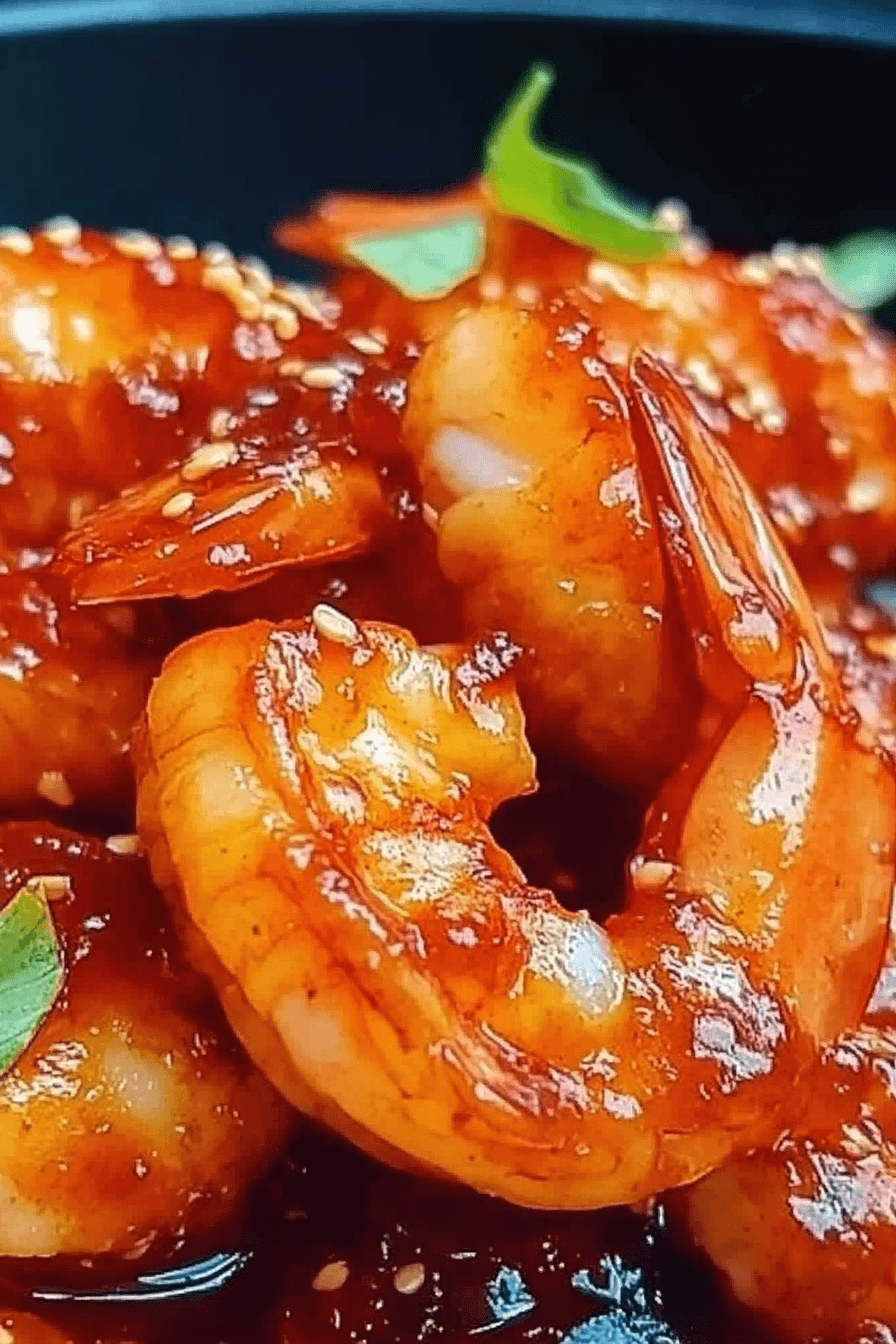Mastering gochujang shrimp: Tips and Techniques
Gochujang shrimp is a fantastic recipe that combines sweet, spicy, and savory flavors into a simple, vibrant dish. This recipe is perfect for anyone who loves easy-to-make meals packed with bold Korean-inspired flavors. It’s healthy, naturally gluten-free, and can be prepared in about 30 minutes, making it accessible for busy home cooks and those mindful of their diet.
One key to mastering gochujang shrimp is balancing the robust heat of the gochujang chili paste with a touch of sweetness, usually from honey or maple syrup, and acidity from rice vinegar. These elements come together to create a glaze that beautifully coats the shrimp without overpowering their delicate flavor.
To ensure tender, juicy shrimp, pat them dry before cooking and control the heat carefully. Cooking shrimp over medium-high heat allows the glaze to thicken and caramelize, giving the dish a glossy finish and enhanced depth.
A quick marinade or toss in the gochujang sauce right before cooking is best, preserving the shrimp’s texture and flavor while allowing an uneven but appealing coating of spicy-sweet sauce. Pair with fresh sushi rice, pickled cucumbers, and creamy avocado slices to complete the balance of texture and taste.
This recipe is a delightful way to introduce Korean flavors into your weeknight dinners and is a great choice for casual gatherings or nutritious solo meals.
Benefits and Advantages of gochujang shrimp
Quick and Easy Preparation
One of the biggest advantages of gochujang shrimp is how fast and straightforward it is to prepare. With minimal ingredients and a no-fuss cooking method, you can have a flavorful meal ready in about 30 minutes. This convenience is ideal for busy parents, students, and professionals.
Flavorful and Balanced
The sweet and spicy balance of the gochujang glaze enhances the natural sweetness of the shrimp without being too overwhelming. The harmony between the heat from chili paste, sweetness from honey, and tanginess from rice vinegar gives the dish an appealing complexity.
Healthy Ingredients
Shrimp is an excellent source of lean protein while being low in calories and fats. The use of sesame oil and rice vinegar adds subtle, healthy fats and acidity, supporting digestion without adding heaviness to the meal. Additionally, incorporating fresh cucumbers and avocado provides fiber, vitamins, and a refreshing contrast to the warm spicy shrimp.
Customizable and Dietary Friendly
Gochujang shrimp naturally accommodates gluten-free diets when using gluten-free gochujang paste. Plus, you can swap rice for cauliflower rice to reduce carbohydrates or modify the heat level according to your family’s preferences. The ingredients are easy to source, and the recipe can be adapted with minimal effort, making it highly versatile.
Why This Recipe Stands Out
Unlike many spicy dishes that rely on heavy sauces or deep frying, this gochujang shrimp recipe maintains freshness with quick cooking and balanced seasoning. It’s a unique fusion of Korean flavors with a simple presentation that works perfectly for modern home cooking.
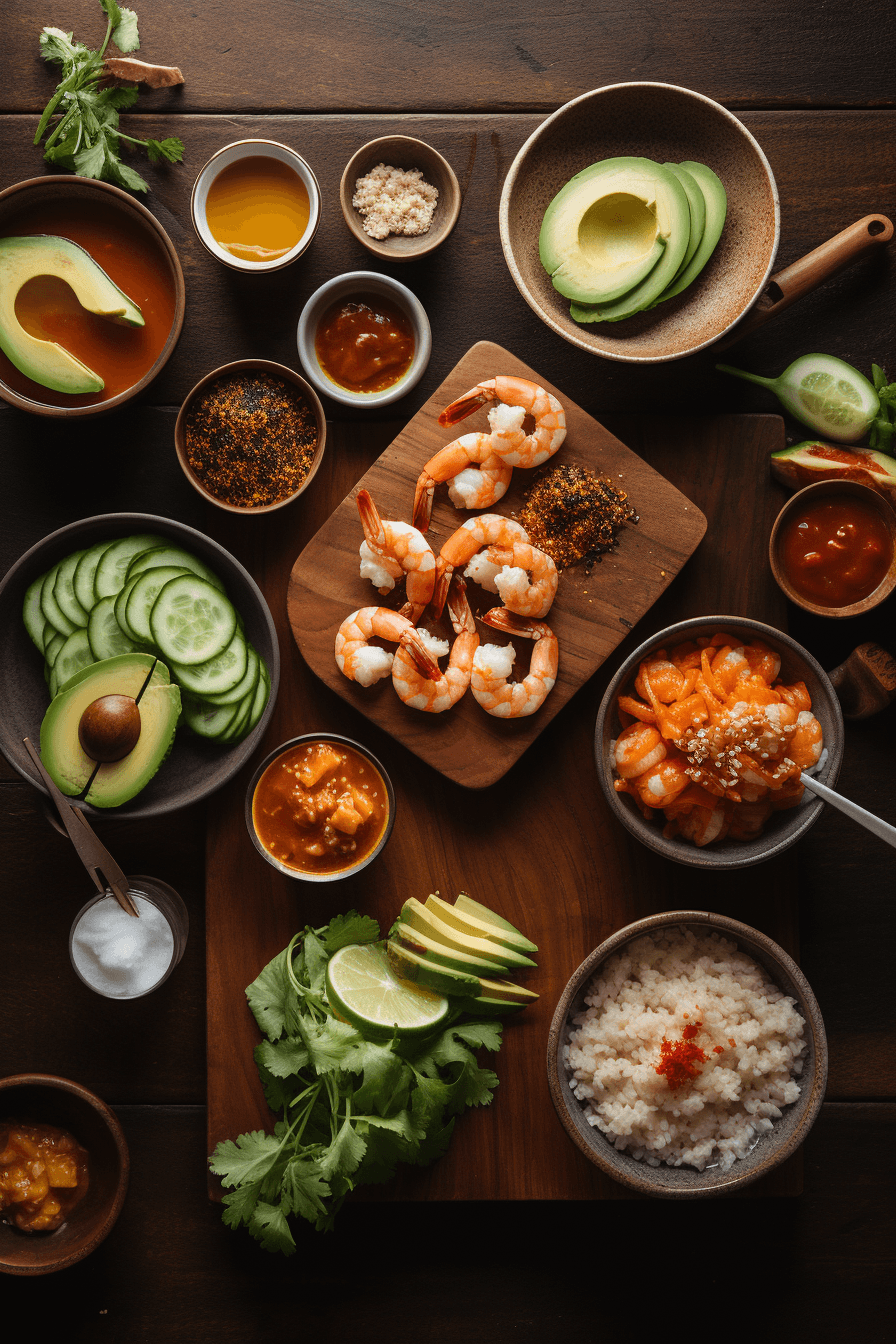
Essential Ingredients for gochujang shrimp
- 1 1/2 cups sushi rice – foundation for the bowl, providing a slightly sticky and soft texture.
- 4 Persian cucumbers, thinly sliced – adds crunch and freshness, lightening the overall dish.
- 1/4 cup plus 1 1/2 tablespoons rice vinegar – used for pickling cucumbers and in the dressing for acidity.
- Kosher salt – to taste, helps balance and season each component.
- 2 tablespoons gochujang (Korean red chili paste) – key flavoring, providing sweetness, umami, and moderate heat.
- 1 tablespoon sesame oil (regular, not toasted) – adds a subtle nutty richness without overpowering.
- 1 tablespoon honey (or maple syrup as an alternative) – balances spice with natural sweetness.
- 1 pound medium shrimp, peeled and deveined – main protein, juicy and tender when properly cooked.
- 2 tablespoons neutral cooking oil – like canola or vegetable oil, helps with even cooking without flavor interference.
- 1 large or 2 medium avocados, thinly sliced – creamy texture contrast, high in healthy fats.
- Toasted sesame seeds for garnish – provides a toasty crunch and visual appeal.
Ingredient Highlights Table
| Ingredient | Role/Benefit | Diet-Friendly Comment |
|---|---|---|
| Sushi Rice | Base for the bowl, mild and sticky texture | Gluten-free |
| Gochujang | Main flavor source; spicy, sweet, and umami | Check for gluten-free label if required |
| Honey | Sweetener balancing heat | Use maple syrup for vegan alternative |
| Shrimp | Protein source that cooks quickly | Low-calorie, gluten-free |
| Avocado | Creamy texture and healthy fats | Vegan, gluten-free |
This recipe’s ingredients can be found easily in most supermarkets or Asian grocery stores. Selecting fresh shrimp and quality gochujang paste will maximize flavor.
Dietary Substitutions to Customize Your gochujang shrimp
Protein Alternatives
If you want to adjust the recipe for varying dietary needs or preferences, several substitutions work well without compromising the essence of the dish.
- Tofu or tempeh: For a vegan or vegetarian version, cubed firm tofu or tempeh can replace shrimp. Marinate with the gochujang sauce for extra flavor before cooking.
- Chicken breast or thighs: If shrimp is unavailable or you prefer mild chicken, thin sliced chicken works nicely. Adjust cooking time accordingly.
- Firm white fish: Such as cod or tilapia can be used for a lighter seafood option, ensuring gentle handling to prevent flaking.
Gluten and Sugar Sensitivities
- Gochujang substitution: Although most gochujang is gluten-free nowadays, check labels carefully. Alternatively, use gluten-free chili garlic sauce mixed with a small amount of miso paste to mimic gochujang flavor.
- Honey: Replace with maple syrup or agave nectar for a vegan sweetener or to reduce refined sugars.
Low-Carb and Paleo Adaptations
- Rice: Swap sushi rice for cauliflower rice or shirataki rice for a lower-carb bowl.
- Oil type: Use coconut oil or avocado oil instead of neutral oils for paleo-friendly fats.
Allergy-Friendly Options
- Shrimp allergy: Substitute with chopped vegetables like mushrooms or zucchini ribbons to maintain texture.
- Sesame oil: Replace with light olive oil if you have nut or seed allergies.
These substitutions make the gochujang shrimp recipe accessible for many dietary needs while keeping the core flavors intact.
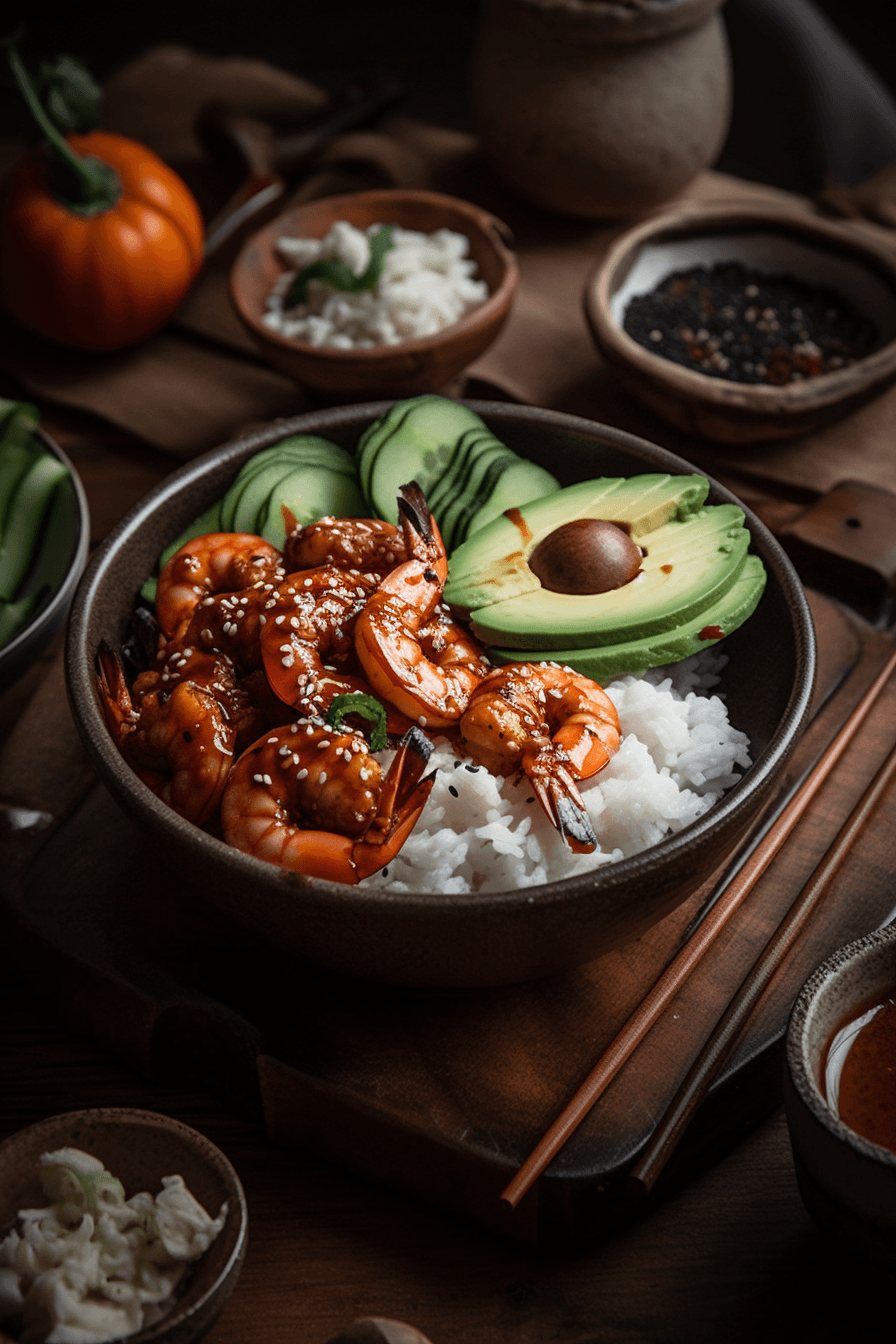
How to Prepare the Perfect gochujang shrimp: Step-by-Step Guide
Creating the perfect gochujang shrimp is easier than it sounds. This Korean-inspired dish balances the sweetness of honey with the rich, spicy tang of gochujang, resulting in a vibrant flavor that works beautifully with succulent shrimp. Follow this detailed guide to achieve delicious results every time.
Step 1: Cooking the Sushi Rice
- Measure 1 1/2 cups of sushi rice and rinse it in cold water until the water runs clear to remove excess starch.
- Place the rinsed rice in a pot with water and a pinch of kosher salt. Bring to a boil.
- Once boiling, reduce heat, cover, and simmer for 15 minutes or until the water is fully absorbed and rice is tender.
- Remove lid and fluff the rice gently with a fork to separate grains.
Step 2: Preparing Pickled Cucumbers
- Thinly slice 4 Persian cucumbers.
- Toss cucumber slices with 1/4 cup rice vinegar and a pinch of kosher salt.
- Set aside to marinate for at least 10-15 minutes, allowing cucumbers to develop a crisp, tangy flavor.
Step 3: Making the Gochujang Sauce
- In a bowl, whisk together 2 tablespoons gochujang, 1 1/2 tablespoons rice vinegar, 1 tablespoon sesame oil (not toasted), and 1 tablespoon honey (or maple syrup as an alternative).
- Mix until smooth and slightly thickened.
Step 4: Preparing the Shrimp
- Pat dry 1 pound of medium shrimp that have been peeled and deveined.
- Season shrimp lightly with kosher salt.
- Coat shrimp evenly with the gochujang sauce mixture.
Step 5: Cooking the Shrimp
- Heat 2 tablespoons neutral cooking oil (like vegetable or canola oil) in a skillet over medium-high heat.
- Add the coated shrimp to the skillet and cook for about 2-3 minutes per side until they turn opaque and pink.
- Reduce heat, add the remaining sauce to the skillet, and stir until thickened and shrimp are well coated.
Step 6: Assembling the Bowl
- Place a generous serving of the cooked sushi rice in each bowl.
- Top with the gochujang shrimp, pickled cucumbers, and thinly sliced avocado (from 1 large or 2 medium avocados).
- Drizzle any remaining sauce over the bowl.
- Sprinkle toasted sesame seeds on top for garnish and a slight nutty crunch.
“The combination of savory, sweet, and spicy flavors with fresh creamy avocado makes every bite an exciting experience.”
This step-by-step guide will help you master the gochujang shrimp rice bowl with ease. For more seafood recipes that combine bold flavors, explore our Shrimp Penne Pasta recipe.
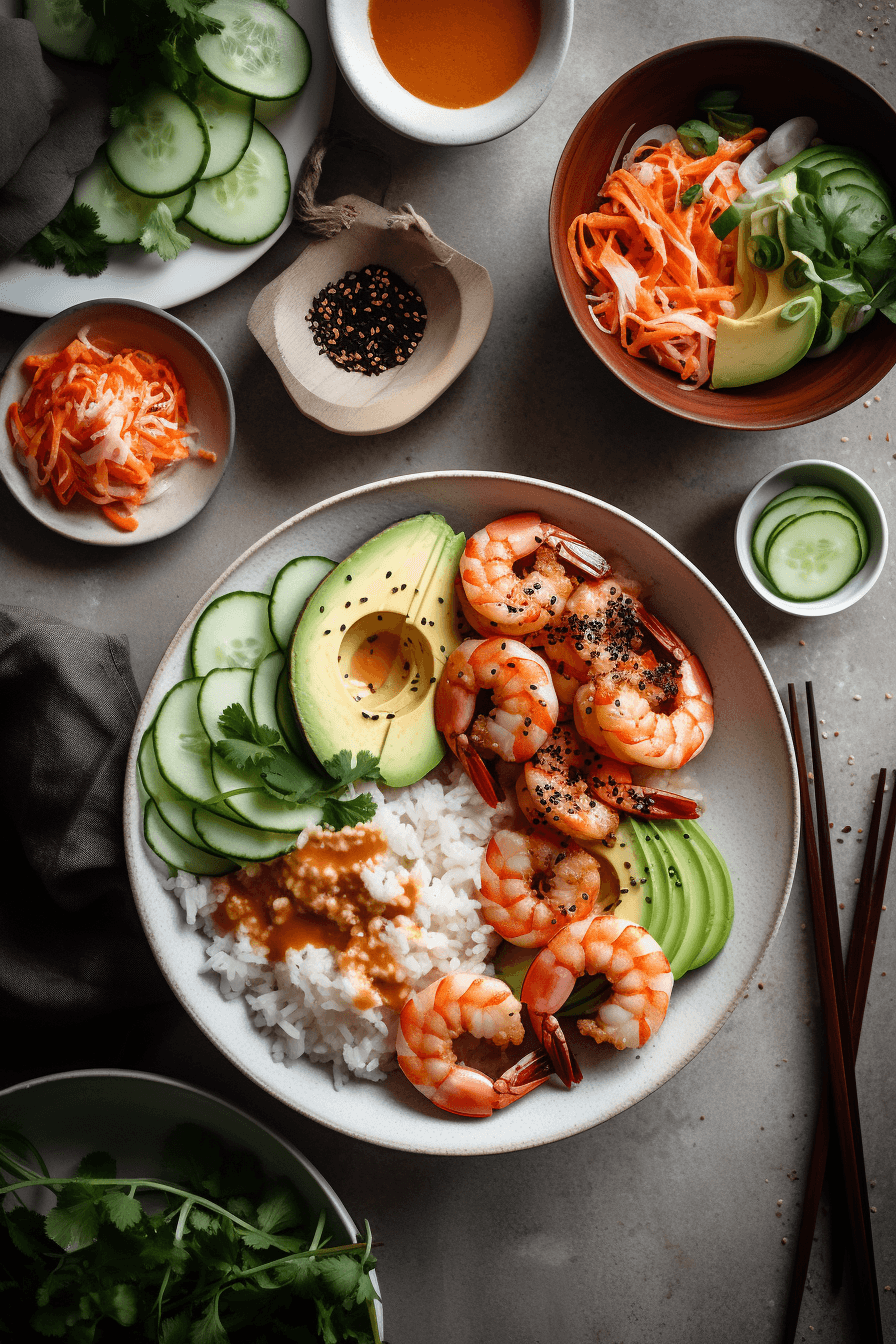
Mastering gochujang shrimp: Advanced Tips and Variations
To take your gochujang shrimp recipe to the next level, consider these tips for cooking and creative variations that offer new tastes and textures.
Expert Cooking Tips
- Dry shrimp well: Pat the shrimp completely dry before coating with sauce to ensure better sear and caramelization.
- Don’t overcrowd the pan: Cook shrimp in batches if necessary to avoid steaming, which can make them rubbery.
- Adjust heat levels: To tame the spicy kick, reduce the gochujang amount or balance with additional honey or maple syrup.
- Use neutral oil: For sautéing, oils like canola or grapeseed work best as they do not overpower the sauce flavors.
- Prepare rice and toppings separately: Store rice, shrimp, and toppings like cucumbers and avocado separately if making ahead to preserve texture and freshness.
Flavor Variations
- Swap honey for maple syrup for a subtle earthy sweetness and vegan-friendly option.
- Add chili flakes or fresh sliced chili for an extra spicy version.
- Use toasted sesame oil instead of regular sesame oil to deepen the nutty flavor.
- Include pickled radish or shredded carrots for added crunch and color.
- Mix fresh herbs like cilantro or mint into the bowl for a refreshing twist.
Trying these adjustments will keep your gochujang shrimp meals exciting and suited to different cravings or dietary preferences. For a comforting side, check out our Roasted Garlic Cheddar Cauliflower Soup recipe for an indulgent pairing.
How to Store gochujang shrimp: Best Practices
Proper storage of your gochujang shrimp ensures it stays fresh and delicious for future meals.
Refrigeration
- Allow the shrimp and rice bowl components to cool completely before storing.
- Store the shrimp and sauce separately from rice, cucumbers, and avocado in airtight containers.
- Consume refrigerated shrimp within 2 days to maintain quality.
Freezing
- Freezing cooked shrimp is generally not recommended due to texture loss; however, if necessary, freeze shrimp alone without rice or fresh toppings.
- Use heavy-duty freezer bags to prevent freezer burn.
- Consume frozen shrimp within 1 month for best taste and texture.
Reheating
- Reheat shrimp gently on the stovetop over medium heat or in the microwave in short bursts to avoid overcooking.
- Reheat rice separately for best texture.
- Add fresh avocado and cucumbers after reheating for a balanced, fresh bowl.
“Separating the ingredients during storage preserves the texture and bright flavors that make this dish so delightful.”
Nutritional Value of gochujang shrimp
This gochujang shrimp rice bowl is not only flavorful but packs a nutritious punch, making it a smart choice for balanced meals.
| Nutrient | Amount per Serving | Daily Value (%) |
|---|---|---|
| Calories | Approximately 370 kcal | 18% |
| Carbohydrates | 38 grams | 13% |
| Protein | 17 grams | 34% |
| Total Fat | 17 grams | 26% |
| Saturated Fat | 2 grams | 10% |
| Sodium | 980 mg | 41% |
| Fiber | 3 grams | 12% |
| Sugar | 9 grams | 18% |
The dish provides a good balance of macronutrients, with high protein from shrimp and complex carbohydrates from sushi rice. Healthy fats come from sesame oil and avocado, while dietary fiber is contributed by cucumbers and avocado. The sugar content largely comes from honey, balanced by the savory and spicy elements of gochujang.
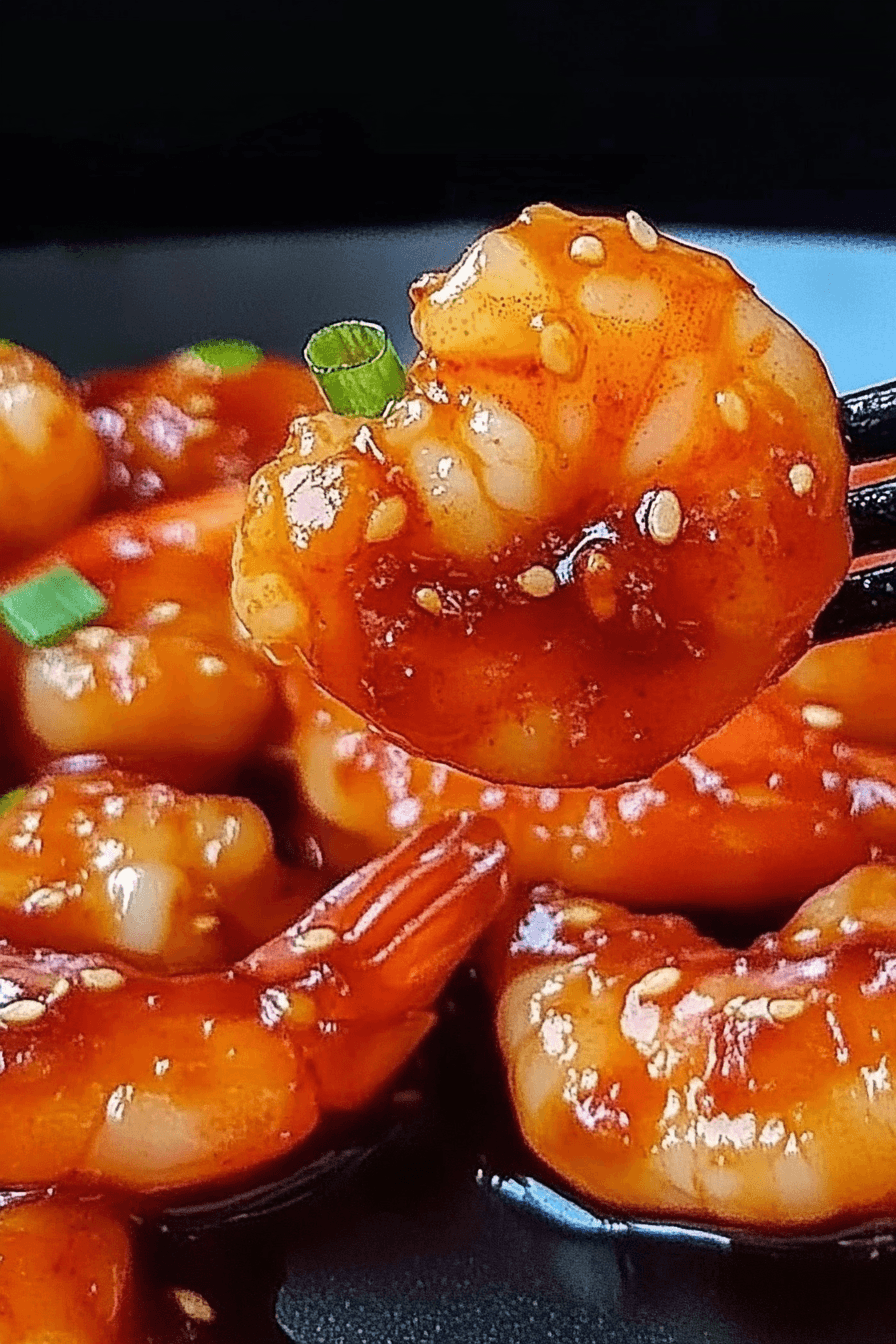
FAQs: Frequently Asked Questions About gochujang shrimp
What is gochujang shrimp?
Gochujang shrimp is a Korean-inspired dish featuring shrimp coated in gochujang, a fermented Korean red chili paste known for its spicy and umami-rich flavor. The recipe typically includes a sweet element like honey, rice vinegar, and sesame oil to create a balanced glaze. It’s popular for its bold, comforting flavors and quick preparation.
How spicy is gochujang shrimp, and can I adjust the spice level?
The spice level of gochujang shrimp depends on the amount of gochujang used, which has a moderate heat. To reduce spiciness, use less gochujang or balance it by increasing honey. For a spicier kick, add chili flakes or fresh chilies. This flexibility lets you customize heat to your taste.
What are some serving suggestions for gochujang shrimp?
Gochujang shrimp pairs wonderfully with steamed white or brown rice and complements low-carb alternatives like cauliflower rice. Fresh or pickled vegetables, like cucumber salad or steamed greens, add crunch and lighten the dish. Try serving it with avocado for creaminess and toasted sesame seeds for texture.
Can I prepare gochujang shrimp in advance?
Yes, you can prepare components in advance, but it’s best to keep shrimp separate from rice and fresh toppings like cucumbers and avocado. Store cooked shrimp and sauce in an airtight container in the fridge for up to two days. Reheat shrimp gently before assembling the bowl for the freshest texture.
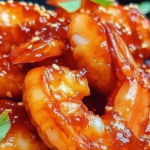
Sweet and Spicy Shrimp with Honey Gochujang Glaze
- Total Time: 30 minutes
- Yield: 4 servings 1x
- Diet: Gluten Free
Description
🍤 Experience the perfect blend of sweet and spicy with this Honey Gochujang glazed shrimp dish. It’s a satisfying meal that brings the zest of Korean flavors to your table.
🍤 Perfect for spice lovers! This dish is balanced with rich textures and a vibrant taste, making it an exciting addition to your weekly menu.
Ingredients
1 1/2 cups sushi rice
4 Persian cucumbers, thinly sliced
1/4 cup plus 1 1/2 tablespoons rice vinegar
Kosher salt
2 tablespoons gochujang (Korean red chili paste)
1 tablespoon sesame oil (regular, not toasted)
1 tablespoon honey (or maple syrup as an alternative)
1 pound medium shrimp, peeled and deveined
2 tablespoons neutral cooking oil
1 large or 2 medium avocados, thinly sliced
Toasted sesame seeds for garnish
Instructions
1. Cook the sushi rice by boiling it with water and salt. Reduce the heat, cover, and cook until tender and water is absorbed, then fluff gently.
2. Toss the cucumbers with rice vinegar and a pinch of salt, allowing them to marinate.
3. Whisk together gochujang, rice vinegar, sesame oil, and honey to create the sauce.
4. Pat the shrimp dry, then season with salt and coat with the sauce mixture.
5. Heat the neutral oil in a skillet over medium-high heat and cook the shrimp until opaque, about 2-3 minutes per side.
6. Reduce the heat, add the sauce, and cook until it thickens and coats the shrimp.
7. Assemble the bowls with rice, shrimp, pickled cucumbers, avocado slices, drizzle with remaining sauce, and garnish with sesame seeds.
Notes
🦐 Use peeled and deveined shrimp for convenience; tails can be removed before or after cooking. Ensure shrimp are dry before coating for better adhesion.
🦀 Store rice and shrimp separately from cucumbers and avocado for optimal freshness.
🌾 This dish pairs well with simple sides like steamed vegetables or cauliflower rice for a low-carb option.
- Prep Time: 15 minutes
- Cook Time: 15 minutes
- Category: Main Course
- Method: Stovetop
- Cuisine: Korean
Nutrition
- Serving Size: 1 bowl
- Calories: 370
- Sugar: 9 grams
- Sodium: 980 mg
- Fat: 17 grams
- Saturated Fat: 2 grams
- Unsaturated Fat: 15 grams
- Trans Fat: 0 grams
- Carbohydrates: 38 grams
- Fiber: 3 grams
- Protein: 17 grams
- Cholesterol: 130 mg

